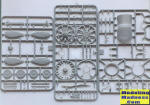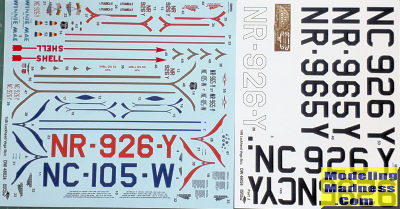
Dora Wings 1/48 Lockheed Vega
| KIT #: | 48024 |
| PRICE: | $40.00 |
| DECALS: | Four options |
| REVIEWER: | John Summerford |
| NOTES: | Some research may be needed. |

| HISTORY |
Courtesy National Air and Space Museum
Introduced in 1927, the Lockheed Vega was the first product of Allan Loughead’s Lockheed Aircraft Company and its designer Jack Northrop. It sported a cantilever (internally braced) one-piece spruce wing and a spruce veneer monocoque fuselage (a molded shell without internal bracing), which increased overall strength and reduced weight. A NACA engine cowling and wheel pants reduced drag and provided streamline style.
In 1918, Jack Northrop devised a new way to construct a monocoque fuselage for the Lockheed S-1 racer. The technique called for two molded plywood half-shells that were glued together around wooden hoops or stringers. But to construct the half shells, rather than gluing many strips of plywood over a form, three sets of spruce strips were soaked with glue and laid in a semi-circular concrete mold that looked like a bathtub. This process reduced the time needed from several days down to about 20 minutes. Then, under a tightly clamped lid, a rubber balloon was inflated in the cavity to press the plywood against the mold. Twenty-four hours later, the smooth half-shell was ready to be joined to another to create the fuselage. The two halves were each less than a quarter inch thick.
Altogether, the Vega's clean, innovative design made it the aircraft of choice for record-setters and racers of the era including Amelia Earhart, Jimmie Mattern, Jacqueline Cochran, and Wiley Post, who became the first pilot to solo around the world.
Wiley Post
The Winnie Mae, a special Lockheed Model 5C Vega flown by famed aviator Wiley Post, completed two around-the-world record flights and a series of special high-altitude sub-stratospheric research flights. It was named for the daughter of its original owner, F. C. Hall, who hired Post to pilot the plane, which had been purchased in June 1930.
With the consent of his employer, Post entered the Winnie Mae in the National Air Races and piloted the plane to the first of its records, now inscribed on the side of its fuselage: ‘Los Angeles to Chicago 9 hrs. 9 mm. 4 sec. Aug. 27, 1930.’
On June 23, 1931, Post, accompanied by Harold Gatty as navigator, (seated in the cabin aft of the fuel tanks) took off from New York to make a world circuit in record time. The first stop was Harbor Grace, Newfoundland. From there, the fourteen-stop course included England, Germany, Russia, Siberia, Alaska, Canada, thence to Cleveland, and finally to New York on July 1, 1931. The circuit was completed in 8 days, 15 hours, and 51 minutes. Halls admiration for his pilot manifested itself in the gift of the Winnie Mae to Post.
Wiley Post spent the following year exhibiting the plane and conducting various flight tests. The airplane was groomed with an overhaul of the engine, and a radio compass and an auto pilot were installed. Both these instruments were at the time in their final stages of development by the Army and Sperry Gyroscope Company.
On July 15, 1933, Post left New York. Closely following his former route but making only eleven stops, he made a 15,596-mile circuit of the earth in 7 days, 18 hours, and 49 minutes.
Post next modified the Winnie Mae for long-distance, high-altitude operation. He recognized the need to develop some means of enabling the pilot to operate in a cabin atmosphere of greater density than the outside atmospheric environment. Because of its design, the Winnie Mae could not be equipped with a pressure cabin. Post therefore asked the B. F. Goodrich Company to assist him in developing a full pressure suit for the pilot. Post hoped that by equipping the plane with an engine supercharger and a special jettisonable landing gear (developed by Lockheed engineers Clarence L. Kelly’ Johnson and James Gerschler) and himself with a pressure suit, he could cruise for long distances at high altitude in the jetstream.
His first attempt started on the morning of February 22, 1935 at the Burbank airport, home of Lockheed. After releasing the landing gear, Post turned east. After only half-an-hour, the engine began losing oil and Post had to make a landing with full fuel tanks on the Muroc Dry Lakebed. (Now Edwards AFB) The landing was so smooth that H.E. Mertz, who was perhaps 400 yards away, tinkering on a wind-powered “sail car” did not hear the Winnie Mae touch down. When Post, still in the pressure suit and helmet, walked up to Mertz to ask for help removing the helmets rear wing nuts, Mertz nearly fainted in terror.
An investigation found that the engine was sabotaged by a jealous pilot. The second attempt started on March 15, again from Burbank. Post reached Cleveland, Ohio, a distance of 2,035 miles, in 7 hours, 19 minutes. At times, the Winnie Mae attained a ground speed of 340 mph, indicating that the airplane was indeed operating in the jetstream.
| THE KIT |
 The
box lid depicts the Winnie
Mae in flight but doesn’t
identify it or name Wiley Post.
The
box lid depicts the Winnie
Mae in flight but doesn’t
identify it or name Wiley Post.
Everything is
sealed in a single bag, with the clear parts in their own bag and
another containing the decals, photo-etch, and vinyl masks. My example
has very crisp molding and detail. Because of the material and
construction method used on the Vega, there is not much to show for
exterior surface
 detail,
so most of the detail is molded in the interior. The parts are spread
across nine sprues and total 70 plastic parts and 11 photoetch.
detail,
so most of the detail is molded in the interior. The parts are spread
across nine sprues and total 70 plastic parts and 11 photoetch.
A 12-page booklet has a cover, parts map, five pages of assembly diagrams, four pages of paint/decal options and the last page a color reference chart calling out Mr. Hobby, Tamiya, Ammo Mig, Hataka. and Life Color paints.
Construction starts with the cockpit, moves on to the engine and cowl, then the wheels. The next seven steps build up the interior, including adding tiny legs to the seats, then the fuselage is closed up. Wings and tail feathers follow, then the engine/cowl sub-assembly. The final steps add the windshield then the landing gear and other underside details.
Decal options are for the Winnie Mae, a Vega flown non-stop from New York to Kaunas, Lithuania by Felix Waitkus, an executive transport for Shell Oil Company, (probably piloted by Jimmy Doolittle at some point during his employment by Shell) and Amelia Earhart’s Vega flown from Hawaii to Oakland. I suspect that, of the four options, only the one in Shell livery had a complete cabin interior.
 Here
the kit is a bit misleading. The kit is faithful to the reproduction of
Wiley Post’s aircraft on display at the Fantasy of Flight in Polk City
Florida. However, the
Winnie Mae has only two
cabin windows—one in the door and the other opposite it. If one wishes
to model it as it sits in the National Air and Space Museum, the super
charger intake will have to be scratch built, otherwise it is modeled as
before the high-altitude flights.
Here
the kit is a bit misleading. The kit is faithful to the reproduction of
Wiley Post’s aircraft on display at the Fantasy of Flight in Polk City
Florida. However, the
Winnie Mae has only two
cabin windows—one in the door and the other opposite it. If one wishes
to model it as it sits in the National Air and Space Museum, the super
charger intake will have to be scratch built, otherwise it is modeled as
before the high-altitude flights.
Photos of Amelia Earhart’s Vega flown from Hawaii to Oakland can be viewed on the Parks Airport website at: https://parksfield.org/airplanes/NR965Y/ Note that this aircraft has the full complement of cabin windows, but no spats on the wheels. If one wishes to model Earhart’s Vega that is also in the NASM, (in which she was the second person to fly solo across the Atlantic) note that this Vega has the same cabin window arrangement as the Winnie Mae and the registration code is NR7952.
| CONCLUSIONS |
Other than the Wright Flyer, perhaps the most seminal aircraft was the Lockheed Vega. So many key aviation figures were involved with it one way or another. I find that amazing for an aircraft of which only 132 were built.
AMT released a rendition of the Winnie Mae decades ago was re-released in the Shell livery about five years ago. That kit is serviceable and needs some scratch building for more accuracy. Dora Wings’ kit is better by leaps and bounds. If one wishes to accurately model the Winnie Mae, the windows will have to be filled in and painted over. Other than that detail, this appears to be another fine kit.
November 2021
Copyright ModelingMadness.com. All rights reserved. No reproduction in part or in whole without express permission.
If you would like your product reviewed fairly and fairly quickly, please contact the editor or see other details in the Note to Contributors.